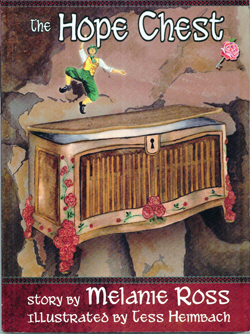The Hope Chest by Melanie Ross, illustrated by Tess Heimbach, Underwood Publishing, (c) 2012, ISBN 9780-6156-2337-5, 168 pages, $13.95.
By Donald H. Harrison

 SAN DIEGO –Leprechauns and kabbalah?
SAN DIEGO –Leprechauns and kabbalah?
Anything is possible, especially in a book written to stimulate children’s imaginations and to carry them off as readers to a far away, magical land.
San Diego journalist Melanie Ross has conflated Irish myth and some Jewish mysticism in a tale in which good leprechauns speak a smattering of Yiddish and Hebrew, and the bad ones have been converted into an unthinking mob of selfish evil-doers.
Illustrator Tess Heimbach makes it all come alive in vivid color with 10 pages of illustrations.
The adventure starts when Bridget, a 12-year-old Irish American girl who treasures antiques, is given a beautifully designed Hope Chest by an old man who wants her to care for it. But inside the chest, miniaturized and cocooned as a result of an evil spell, is Farleigh, a beautiful, young Irish woman, who is devastated to learn that she has awakened in the 21st century instead of the 18th, and that she is now in America instead of Ireland. Farleigh doesn’t know why this happened to her; she knows only that she had been betrothed to Connor, a princely young man, before the disaster befell her.
Bridget confides her amazing discovery to her best friend Esther, an Orthodox Jewish girl, and together they ponder what, if anything, they might do to help Farleigh break the evil spell and somehow be reunited with Connor. They find that they can both fit into the trunk, and then …. they are embarked with Farleigh on an adventure that transports them through time and space.
Esther reads and speaks Hebrew and this comes in handy in a land where words and letters from God’s own language have tremendous, kabalistic power.
In Ross’s book, children of different faiths and ethnic backgrounds (another character in the tale is Natalie, a Filipina) form close friendships notwithstanding the prejudices or close-mindedness of their parents. These children also are open to new experiences , while hewing to their own traditions. For example, Esther, at one point visiting the home of a very old priest, keeps to her kosher diet by eating only pareve foods.
An underlying message of the book is that good people will recognize and trust in one another, even if their ways seem strange. I’ll be delighted to have my grandchildren read this adventure story.
*
Harrison is editor of San Diego Jewish World. He may be contacted via donald.harrison@sdjewishworld.com